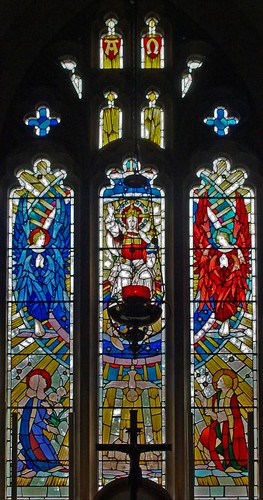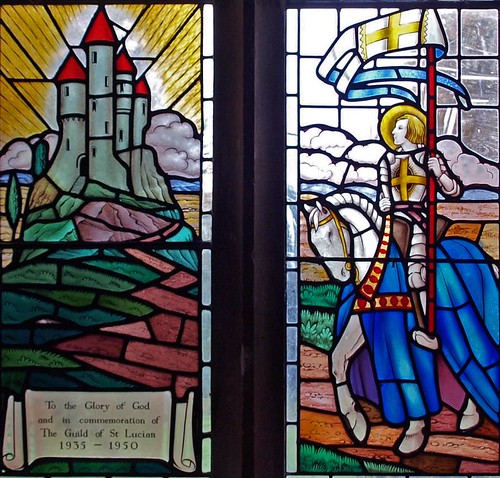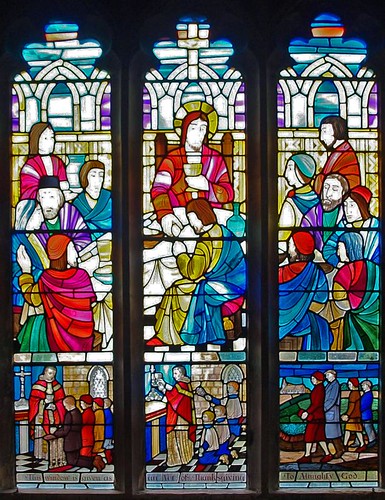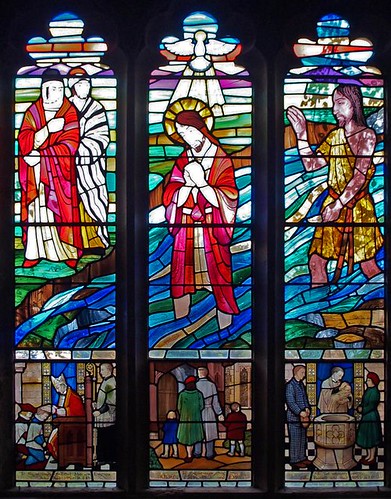All Saints is fairly unprepossessing but does house four good windows, two by Reginald Bell and two by his son Michael Farrar-Bell. The interior has been much restored following the detonation in 1940 of a land mine which badly damaged the south side of the church, the nave roof, the stained glass and tracery and the belfry and little else of interest remains. The belfry, which Pevsner calls 'The most interesting part' is sadly locked.
ALL SAINTS. The most interesting part of the church is the belfry. Square ground floor with four posts set so as to form a Greek cross with four small corner spaces. The W arm serves as the entrance to the church. It has a doorway with three tracery panels over. The N and S arms have one three-light traceried wooden window each. The tracery differs slightly. The centre is braced from N to S as well as E to W. The arms have N-S braces. Trellis-strutting above from E to W and N to S. The upper part of the belfry has a stirrup on the E side. Tall bell-stage and tall thin broach spire. The weatherboarding is dark and vertical below, white and horizontal above. Of timber also the S porch, with six ogee-arched openings on the W and E sides. The doorway has blank panel tracery above. The church itself is of less architectural interest. The E chapel of the aisle and the chancel are of 1848. The front of the S aisle is heavily renewed. N arcade inside of three bays with octagonal piers and double-hollow-chamfered arches, that is C15. The chancel roof has recently been prettily painted, somewhat in the taste of Sir Charles Nicholson. - CHAIRS. In the chancel two richly carved late C17 chairs. - BRASS to Richard Twedye d. 1574, in armour.
STOCK. On the hills between Chelmsford and Billericay, it has a pleasant green made bright on one side by the vivid red of a row of almshouses, and has at one end one of the most delightful timber spires in Essex. It rises on the belfry of the 14th century church, the belfry being also of wood, older than the church itself. Above the doorway of the belfry are three square windows with lovely tracery, and inside is one of those amazing timber constructions characteristic of this part of England. So huge are the curved beams that the biggest oaks in the forest must have been felled for them. The arrangement of the beams makes a pleasant design, all meeting in a grotesque boss.
The medieval masons were still extending the church in the 15th century, adding an aisle and leaving us the quaint round face of a monk looking down on it. There are four poppyheaded bench-ends from the pews of that period. On the wall behind the pulpit is the brass portrait of Richard Twedye in his 16th century armour, set in an old altar stone with two consecration crosses. It was he who built the almshouses on the green, as a comfort for the declining years of four knights fallen on hard times.
Flickr.
The medieval masons were still extending the church in the 15th century, adding an aisle and leaving us the quaint round face of a monk looking down on it. There are four poppyheaded bench-ends from the pews of that period. On the wall behind the pulpit is the brass portrait of Richard Twedye in his 16th century armour, set in an old altar stone with two consecration crosses. It was he who built the almshouses on the green, as a comfort for the declining years of four knights fallen on hard times.
Flickr.




No comments:
Post a Comment